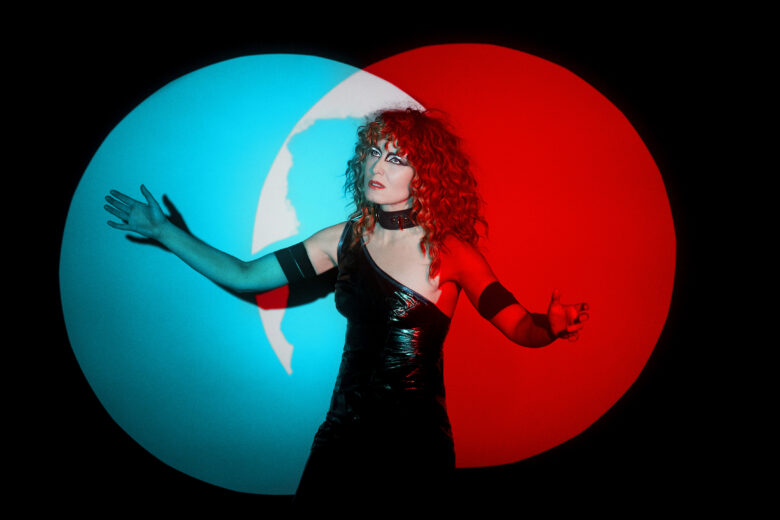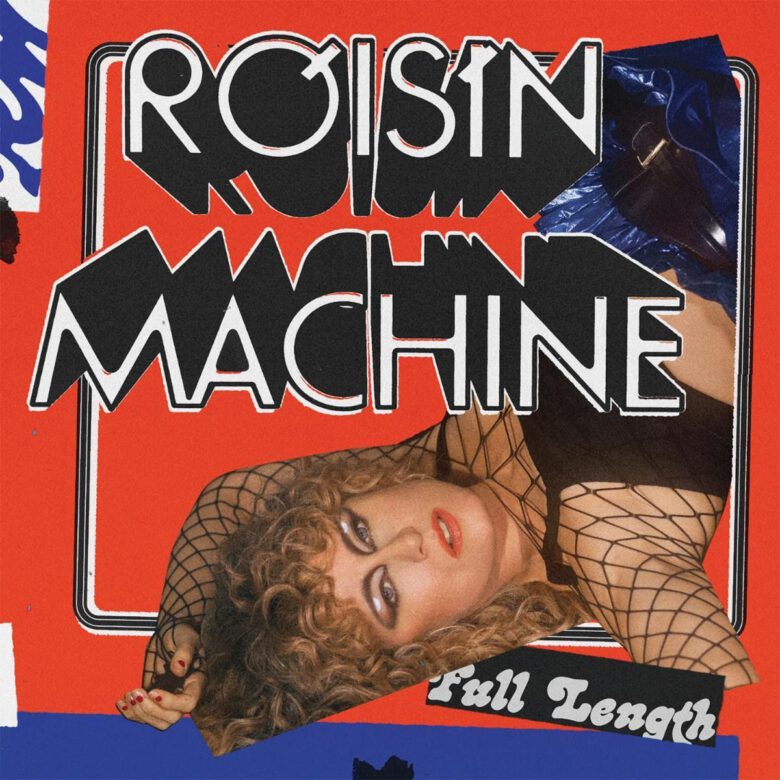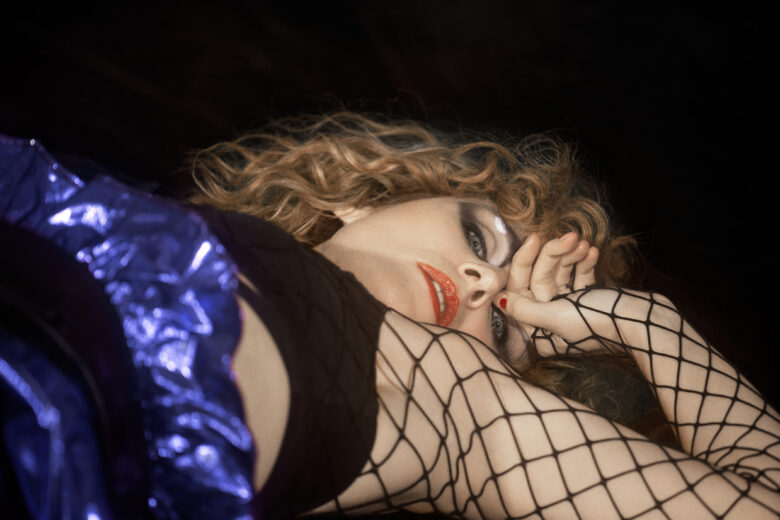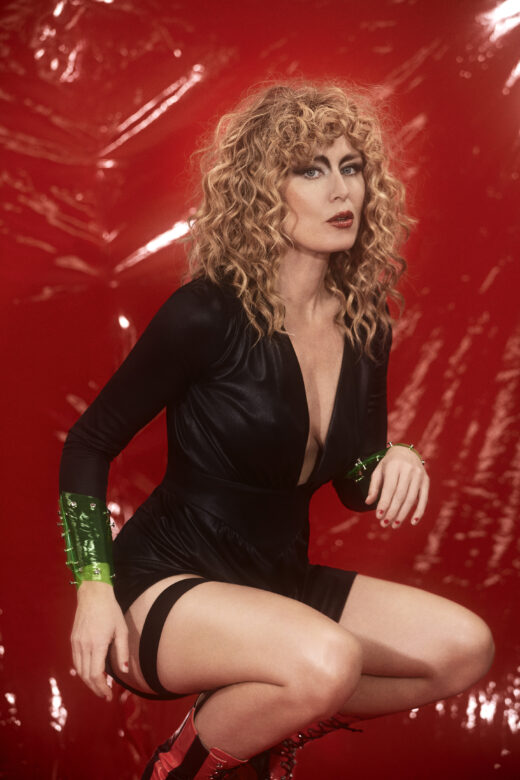Full disclosure – if you think this intro is going to shy away from unabashed idolatry in the name of journalistic neutrality you’ll be wildly disappointed. At the moment, Róisín Murphy is promoting her muscular new record, Róisín Machine [listen now], which is already being hailed as a modern classic – or at least it is now!
The record has been somewhat unfairly promoted as a disco record – a purist term that limits the depth and variety of influences that informs her every move. Leave it to Murphy, however to further futurize a genre that has, since its inception, been subject to evolution.
It’s improbable that Murphy could make a genre-specific record, a born rule breaker since the early days of her first band, the Sheffield-based duo, Moloko. Her formative years populating clubs in Sheffield and Manchester remain at the forefront of her inspiration. Her influences range from industrial music, to punk, techno, and most recently to massive dubbed out disco classics. It’s unsurprising that her own projects have veered into almost all of those genres without ever approaching parody or disingenuity.
As hard as she may try, Murphy seems incapable of complying to tradition. On the cusp of three decades in the music industry, the 47-year-old’s body of work defies categorization, which explains her adoring fan base’s indefatigable interest in her work.
As if her soon-to-be-released record weren’t exciting enough, the self-proclaimed Machine can’t help but share incredibly exciting news about her next project and her aspirations for after fifty.
In an attempt to contain her multitudes to one article, we chatted with the iconic disco-punk queen about her legacy, her relentless creative curiosity, reputation, and her many cultural infatuations.
Read the full Q&A after the jump!
�
Congratulations on the new record – It’s so packed with bangers! Thankfully, there were some outdoor end-of-summer micro-parties popping up where we were able to enjoy some of the singles on a big sound system with friends.
Thank you! Well, I’ve been to quite a few small parties recently and I’ve enjoyed that immensely. I was in Ibiza in August and yeah, we certainly took advantage of that a bit!
I’d like to get very gay right off the top. I was wondering if you tend to get more interest from Queer publications like this one, or are you finding you’re talking to more mainstream publications as your career evolves? Do you notice a shift in demographics with each release?
Well, I guess I have different kinds of demographics in different countries. I do have a very strong gay following across the board. But in some places it’s really gay, like in America, for example. When I played there, it was like wall to wall, lads with their tops off in their underwear. Everywhere. Hardcore! I love it, mate.
You know, the thing about the last tour that I did in America – I didn’t do big venues or anything, but it really made me aware of having to be on top of my game with the singing and all that!
Why? You mean because with the Gays you have all those other divas to compete with?
Well, just being in a completely gay environment, you know, completely mad people hanging out and sweaty bodies everywhere, and they’re loving it. It’s such a beautiful thing and it becomes a full circle for me, because I was always brought up to understand that the music I was into had been created by gay and marginalized cultures.
So, to then be embraced in that same kind of culture, I mean, maybe I’m not mainstream gay culture in America, I’m not sure if I even have the possibility to be, but certainly the, the parties that I’ve played there have been pretty full on!
Most of my friends that listen to your music are very art gays than say, more mainstream types, so that’s a very skewed scale – you’re very central to us, diva-wise! Do you recognize that kind of iconhood that you’ve achieved within certain communities?
I’m not bullshitting you, I’m utterly grateful to be accepted in that world. Right from when I moved to Sheffield, people like [Róisín’s long-time collaborators] DJ Parrot, and Mark Bryden always educated me about where club music came from.
Things got much more gay towards the end of the Moloko time, but definitely solidified as a fanbase for me as a solo artist. It makes me feel like it’s all worthwhile, the fact that what I do touches the people, the culture and the outlook that it was inspired by.
Each record you release seems to correspond with a different aesthetic – drawing inspiration anywhere from club legend and fashion icon Leigh Bowery to a more Siouxsie Sioux-esque punk version of a disco diva on this new record. Can you talk about how you arrive at the looks at the forefront of the records, and how all those references became sort of remixed into the Róisín Machine look?
I think for this one, the first moment for me was seeing Cosey Fanni Tutti‘s exhibition here in London. She’s the lady who was in Throbbing Gristle and also Chris and Cosey and many other projects. She’s always been at the forefront of these radical forms of music, and also visual art.
So, this show I saw involved these huge format photographs of her tied up, or various powerful images of her naked body. At that time, standing in front of these images I just wondered where had all that gone? There’s nothing with this much balls or this much sense of self-ownership in female imagery at the moment.
I also started to listen to her music a lot, but also then I just sort of set off on a bit of a journey, looking at punk. Especially work by people like Derek Ridgers who’s been photographing the scenes in and out of London for forty years now, but also used to photograph rock stars and did a lot of music photojournalism.
Also reading about people like Cabaret Voltaire, and Human League. Them guys in Sheffield, you know, Sheffield’s a hard core working class town. It’s a steel factory town, that’s essentially what it was built for.
So, these lads saw Roxy Music on The Top Of The Pops — and I’m talking about the straight guys now, like from the Glam Rock years — these guys would be left to run the gamut from their house to the centre of town wearing makeup, and like high heels, and their sister’s blouse and feather fucking boas, you know?! They risked getting beaten up and threatened or have to run the gamut of possibly being killed for wearing their sisters’ blouses.
That whole Glam Rock era is definitely the beginning of everything that inspired me, in terms of as a performer, a visual artist, and music maker. That attitude of “more is more” mixed with this curiosity, wit and humour, and then the balls to carry it off. I wondered where that had all gone a bit.
Also, reading about New Yorks’ Danceteria, where there would be the art crowd, and the goths and hip hop all listening to DJs playing stuff like The Cure right up beside Larry Levan’s music, you know?
The fact is that Róisín Machine is disco at its center, and does have this very High NRG feeling with camp moments, and moments of humour, but sometimes it’s cold and sometimes it’s hot. It has all of this sort of stuff that’s associated with disco, but at the end of the day, it’s got this cellar underneath it. It’s like a Sheffield-style party in a fucking cellar.
The record is being described as disco but it goes many places, and gets pretty dirty, production-wise.
Because it’s real dirt that it comes from, you know? You can’t put dirt onto something and have it feel dirty — It’s got to be actually funky to be funky, if that makes sense!
With your last album, Take Her Up To Monto, there was a lot more going on in terms of specialty and room in the songs, whereas this one goes straight into much more meaty, banger territory. How does that come together in terms of vibe with each album? Do you have a backlog of songs that you clump together based on those similarities between songs, or do you go into each record writing based on an intention, style-wise?
I mean this was only Parrot and myself, you know? And then Monto was only me and [long-time collaborator] Eddie Stevens. That’s the great thing, it’s sort of similar to a sexual partner when it comes to working with producers!
You don’t have to sit with the same people like you do in a band or whatever. You can be a bit more promiscuous, and each project can be completely different.
This album has a bit of a “fuck it – let’s dance” theme running through it. On “Shellfish Mademoiselle,” you sing “I know I shouldn’t be dancing at a time like this.” Given the era within which this record is being released, something as simple as that gesture feels almost political. Does it feel that way for you?
I mean, that’s exciting in a way that even things that weren’t politically charged become politically charged in a new and exciting way? It’s like when I released “Murphy’s Law,” which was actually written a while ago but came out right at the beginning of lock down, and so many people were like “Oh my God, you’ve written the story of my life!”!
All of these connections and synchronicities… I do believe in synchronicity, especially in creativity; it really forces synchronicity and it forces you to allow things that you didn’t expect to happen.
On “Incapable”…
Oooooh — she’s a bit of a bitch! She’s the antithesis of what you expect to girls to be singing about in regards to heartbreak. She’s saying, “I got away with it — I got out of it without a broken heart!”
She’s saying, “I got away with it. I got out of it without a broken heart!” Obviously, there is that question, you know, “am I capable of love? Is there a reason why I had a broken heart? Could it be that I’m not loving when I think I am”?
Or like, addressing what a woman’s supposed to want from a partner – or a “male” – in this passive, tragic way?
I like that the question is left open, because I think a lot of people write about heartbreak in a way that’s meant to come to a conclusion at the end of a tragic love song.
I’m not doing that at the end of it… It’s more of an inquiry than a desperation. It’s quite old fashioned in a way. It’s very Peggy Lee to me, it’s sort of Santa Baby in a way! She’s got a glint in her eye like the old divas had.
When I look back at those older divas, and I really got into the Italian ones — things were of course more restricted for women and they had to employ this wit and cunning in order to outsmart them — and I think that’s situation in “Incapable” as well.
Another enormous track on the record is “We Got Together,” which feels almost like the inverse of “Incapable”’s inquisitive, romantic themes in that it just celebrates hooking up and having a wild time.
“We Got Together” is just such a simple refrain — it just does what it says on the tin! And it’s just about that! We got together in the past. We moved together. We grew together. We danced together! Well, fucking come on!
It’s pretty jaw dropping in its directness. It’s a full-on refrain that we do universally need — no frills added!
To be honest, the refrain came from ad-libbing it on stage on top of another song, “Flash of Light,” which is a much sadder song. So, when I was initially writing it there was actually much more pain in it! It was more begging “We did get together! Didn’t we?!”
How did you come to work with songwriter Amy Douglas on the single “Something More”? At what point do you connect with a set of lyrics and decide to commit them to a song?
Well, she worked with Parrot on his solo record, so we were in touch. She came to London and I invited her to speaking event with Andrew Weatherall and it was really fucking great.
We were very noisey, having drank a lot of whiskey and we were like heckling him, but in a nice way! He enjoyed us though, and told us he liked both of our most recent records!
Oh! I would have assumed you knew Andy Weatherall, given the parallels in your careers, and spending time in clubs in Manchester and all that!
No! Not really! But sadly, that was the last night we ever saw him [Weatherall passed away unexpectedly in 2019]. But there’s a bit of Andrew in the mix of “Something More” because we were talking that night about what we could do together.
I wanted [Amy] to write me a High NRG-style track and make it about wanting more! More and more, and, you know, this exponential need to just keep going, to get more and more. So, she pretty much wrote it overnight.
I can’t recall now what the original tempo of the song we did was, but it was more like something off Overpowered, and felt really old fashioned in a way — it was very poppy. I sat back and listened to it and thought “who wants that”?
I did a mix recently for BBC where I went into my deep love that Berlin dub/techno crossover, the early nineties like, Rhythm and Sound crew stuff. So when I heard the remix we did of “Something More,” which is now the mix that appears on the album, I just thought that’s fucking it! That’s what people need.
I mean, I don’t know what they want, but I know that’s what they need. It had this echo of like… I could imagine Andrew playing it, really, as the last record with the sun coming up?? Come on! So, that’s what I felt like doing and what I say goes!
There must be so many variations of tempo and mixes and remixes when producing electronic music. How do you settle on whichever avenue you end up committing to?
That’s the beauty of it. Obviously, there’s all these different outlets, and so we’ve got these remix packages that mean quite a lot actually in this project. They’re no less a part of the story than the album versions.
With Crooked Man [her collaborator, DJ Parrot’s other project], the story started with us talking about dub music and dubbed-out disco records. We were talking about the early origins of when people started to make dance records out of other styles like soul records and R&B records and stuff like disco records and where people were playing these records and changing the arrangements, and where it had developed from a DJ actually needing to extend those versions.
You recently mentioned South African-style Shebeens and Jamaican Sound System culture as a source of inspiration. Both combine a DIY, community-based sensibility but with mega, mega amounts of sound in quite intimate places. Can you tell us more about that?
Well, taking people down to smaller numbers does feel right, as well to go somewhere and actually listen to music. That’s what The Loft was in 1970’s New York. It was a place to go and hear music on a system that was really loved and really built with love.
Also, there wasn’t any mixing or anything like that — the focus was on the songs, and very small numbers of people in attendance. I did a DJ set the other night for two people and it lasted for hours! I think this is what we’ve got to do.
Also, local condensed things are the ones that make record labels that make great records, and everything else that comes off of it, everything else that flows naturally out of the love of music. Really the best of it comes out of condensed local scenes that are built from the inside out. And they feel like families as well when you’re in bond, which is how I felt when I was initially learning about all these things.
Beyond being a musician and director, there are so many elements to your work that obviously step into avant-guard, conceptual territory. Do you perceive yourself as a conceptual artist more-so than just a musician?
Well, I definitely came into the business of making records conceptually, rather than as a musician. I mean, I came in saying stupid shit on Mark’s [Brydon, of Moloko] records! I’d be encouraging him to make certain types of music and telling him to avoid other styles.
I was very reactionary as well — I was nineteen when I met him — and he was thirteen years older than me. So, he kind of must have got some energy off that. So we made things like our first track “Tight Sweater,” and things where I’d act like a valley girl who is afraid of all the party weirdos, even though in reality I was the biggest party weirdo of them all. So, it was more like acting.
So, the concept fueled ideas, and then led to trying to syncopate those ideas a bit more. We started doing with songs like “Fun For Me” and “Where is the What if the What is in Why”and started to get a bit further into singing than just talking over the tracks.
So, gradually when we finished the music part of it, we thought, “Fuck, what are we going to do visually, because we’re not technically a band?!” Gradually, the realization was that we needed to make a video, and that we’d be in it.
So, we did “Domonoid” and it turned out I was a natural, believe it or not! So, singing more as it went along and incorporating the visual aspects gave everything more range.
Speaking of developing as a singer, your vocals are really out of control and powerhouse on this record. Can you talk about arriving at those performances?
Parrot was very insistent on that from the very beginning when we started working on tracks all those years ago [the duo began collaborating on Róisín Machine tracks as far back as 2012]. I would be recording in a proper studio with very proper gear and he wanted to continue that way going into recording again this year.
So, the songwriting is strong and the vocal production is very strong, so it comes through and the choices of takes he chooses. He’s got an exceptionally good ear for choosing the way the overall performance is in the end, because he will choose a take out of say three or four runs that I will do when recording.
He usually chooses the “rightest” one, if that makes sense. Parrot’s super-focused mind is looking for the proper vocal take, like full on proper like the way it was done in in the seventies, whereas somebody else might be looking for something weird creeping in on the take, you know?
He’s not looking for quirks in a sense; my quirks are already there and he has to live with that. But that’s not the right take for every project — like in contrast to the productions I’m doing with DJ Koze for my new record, that would be the opposite approach.
Oh, wow. Wait what? Okay. That collaboration is very exciting news! So, I want to address the fact that people have been ripping you off for years…
Oh! They’ve been snatching my wig!!!
Do you reflect on that? Does it muster any conflicted feelings about recognition for your work where potentially more visible artists in the mainstream are regarded for work you’ve done more fearlessly?
Not really, because I am regarded for it and I do get recognition for it! You know what I mean? So, I’m in the right places. I wouldn’t like to be a superstar really, at the end of the day, I’d like my work to be a superstar at some point, and the whole catalogue: the Moloko albums, the solo albums, collaborations, singing in Italian — whatever it is I’ve done.
It’s all part of a bigger story now, rather than some shoulder pads or anything like that somebody might reference. As things go on into my 27th year of doing this, the whole catalogue becomes “the thing.”
I mean, reference things as well! I told you about a couple of things that fascinated me during the making of the visuals for this record. I am always one for completely acknowledging where I’ve took reference from. I think its good to reveal what has inspired you — It’s not going to take any shine away from what I do at all.
Especially the recent culture of the Internet explosion, and having access to whatever reference you fucking like. Plausibly, you could be really stupid, and have created a network of very interesting people online with great tastes and just screen grab and take it from them without acknowledging that, and that’s not acceptable for me, to be honest. But it happens across the board, not just to me.
Really young producers today end up making some really strange music out of that vastness, because they’re discovering Marilyn Manson at the same time as say Frankie Knuckles or whatever weird drum and bass. The resulting sound is valid; the only thing that’s missing is the awareness of context.
It does sound interesting; I guess an example of that is somebody like Billie Eilish, who as far as I’m concerned is a really great pop star.
They’re using all these techniques that were developed in dance music and in clubs that came before them almost through osmosis — dance music’s always been futuristic music as far as I can remember, or had a forward momentum and her and her brother in their bedroom are using echoes of that, but meanwhile they’ve not even been in any nightclubs because they are too young probably, so it’s like, it doesn’t fucking matter!
There’s this ongoing theme on the record of “I feel my story is still untold.” Having mentioned your twenty-seven years in the industry, are you in a reflective state about your career?
Hmm, maybe contemplating it, but maybe more-so just sitting back and going, “Wow! You know, I still look good! Me story’s still untold! Come on!!!! Come and have a dance with yer mum!!! Never had a broken heart, fuckin’ hell! Lets have it! Still fuckin’ havin’ it — 47 and absolutely gorgeous!”
There’s something more. Like your film career, which you really dove into with directing the Italo-drama videos on Hairless Toys.
My rough plan is that I will be concentrating more on film in the fifties, and I’m forty-seven now. Those videos were like their own little film school because they were really referencing super famous Italian directors and looking at how they actually shot things and actually recreating them.
So, you’re already onto your new record, and this one hasn’t even been released yet. Are you at the mercy of record label politics where you have to wait like five years and then put out a record or are you kind of just like, “fuck it”?
No, no, no, no, no, God, life’s too short for all that, and they’re all exceptionally different from each other, these projects. So thank God I can blast it out!
— Q&A by Kevin Hegge (@theekevinhegge)
Róisín Machine is available now for purchase or streaming.





Excellent interviewer!